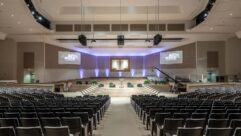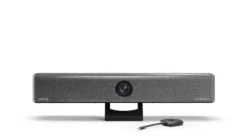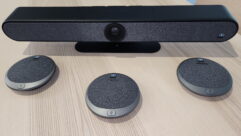
The Medium is the Message
May 24, 2010 12:00 PM, By Cynthia Wisehart
Content and technology drive digital signage.

Last month, for Earth Day, Show+Tell brought worldwide interactivity to the Times Square ABC SuperSign on behalf of Siemens and Earth Day Network, posting tweets from around the world on how to go green.
Photo by Jason Woodruff
When Marshall McLuhan said, “The medium is the message,” it was 1964, and although he meant all media, he foresaw the profound impact of the newest medium: television. Like Einstein imagining relativity with a single equation, in five words, McLuhan summed up the forces of the universe.
Related Links

Enhancing Corporate Communications via Dynamic Digital Signage
With corporate cutbacks and an economy trying to get back on its feet, corporations of all sizes are struggling to find cost-effective ways to communicate timely information to their busy employees. …

The Case for Digital Signage Content: Viewer Experience Strategies
There are three basic types of digital out of home (DOOH) networks that determine both the placement and approach to creating messages….

Digital Signage Templates: Feeding the Beast
Regardless of the type of network or the frequency of content refresh, keeping the content machine churning is a potentially daunting task. …
McLuhan’s observation is only more appropriate after 46 years. Just as the broadcast-dominated culture defined a time in human history, today’s on-demand, interactive, media-is-everywhere environment is rapidly changing the laws of cultural physics. It’s also changing the sales process and cycle for AV. How users experience a given medium affects their perception of the message. That means systems design and implementation must serve business and communications objectives more specifically and astutely than ever. The combination of content and technology, medium and message, will drive the next wave of AV.
Digital signage or digital out of home (DOOH) is part of that reality, and it has a long way to go. Though it may seem to be a niche, it is actually representative of an overall trend toward ever-more-integrated systems. It is also a media platform like none pro AV has ever seen. Here’s why: In the past, pro AV systems were imagined, needed, and designed to serve a purpose that was already clearly understood by the customers—we want music in this restaurant; we want to see the ball game in the snack bars; we need a videoconferencing system. Even in entertainment, where AV is at its most creative, clients knew they needed a show. Systems were purpose-built for a relatively narrow purpose.
Digital signage is coming into the world a different way—often as a platform for uses and business models that are just beginning to be understood. Therefore, AV professionals must help make the value proposition clear to potential customers. Digital signage also blurs the lines among stakeholders (content creators, users, systems integrators, technology managers, architects) in new, interdependent ways, which creates a new sales cycle based on customer relationships and knowledge of their business goals.
Don’t think of digital signage as an application. Think of it as a medium. Use that now-tired term “ecosystem” if it helps. Successful digital signage will sell in a variety of ways. Marketers and advertisers will be advocating it to their clients in part because it is an annuity: Once the network exists, it must be fed by content created by the marketer and advertiser. In the past, advertisers, content creators, and marketers did not have to know much about how television commercials were broadcast, how billboards got made, or how magazines got printed. Those delivery mediums were a given. But with digital signage, the content and the delivery medium are developing concurrently. This will drive the collaboration among technical and creative forces.
With that in mind, we talked to two companies that are modern examples of digital signage/DOOH businesses—the kind of business you might want to emulate or partner with as you try to stay current with where AV is going as a whole.
Neither of these companies considers itself a systems integrator, though both are technically experienced and sophisticated. Both companies contract systems integrators and partner with them in other ways, and they are actively looking for partners.
The Medium is the Message
May 24, 2010 12:00 PM, By Cynthia Wisehart
Content and technology drive digital signage.

Show+Tell’s own relationships are with a variety of stakeholders—sign owners, advertisers, marketers—and sometimes with the brands themselves, as was the case with M&Ms.
Show+Tell
For the past 10 years, one of the iconic benchmarks of digital signage has been the ABC SuperSign in Times Square. New York-based Show+Tell has been a key player in the technical specification, evolution, and content creation for the sign since inception. Last month, for Earth Day, the company brought worldwide interactivity to the venerable sign on behalf of Siemens, posting tweets from around the world on how to go green (see image at the beginning of this story), and then relaying back the image from the big screen to the source. Talk about your 15 seconds.
When Phil Lenger founded Show+Tell in 1989, he was an NBC broadcast veteran—one of the pioneers of PC-based computer graphics for election coverage (as well as a Nashville, Tenn.-trained audio engineer and a graduate of New York University’s film and television department). While he was pioneering nontraditional graphics for the broadcast screen, he also had a hand in AV for NBC’s annual upfront week shows at Radio City Music Hall, and later for ABC and the NBC studio tour.
These types of experiences served him well in a career he describes as a “science experiment.” Show+Tell’s early work was in what used to be called “multimedia”—CD-ROMs, kiosk design, and the like. Then as signage, inter¬activity, high definition, and metrics came into the mix, Show+Tell followed the flow. “We are often inventing the screen, in a shape or aspect ratio that didn’t exist,” he says. Likewise, the need for an underlying infrastructure with its network elements of scheduling, content management, and measurement was a familiar challenge.
“But we’re not a systems integrator and we’re not interested in being that. Our core is coming up with the ideas and concepts,” he says. “We’re technically literate; we love gear; we understand systems. We can do high-level system design; sometimes we’ll do the CAD drawings; we know what processors or switchers can support the resolution or application we need; and we can program software to adapt something when we have to. But we don’t want to source and install the system components unless the system is very simple, like a single-source display. We don’t build racks, wire, or test.”
Lenger says Show+Tell’s partners (including Scharff Weisberg and XL Video) also help the company walk the line between envisioning something that has never done before and knowing that it can realistically be done with the time and money available.
For Show+Tell, every job is different—though the company broadly identifies two market segments. The first is digital out of home, which is essentially nonbroadcast networks, something it has done for more than 10 years for clients including Blue Cross/Blue Shield, Bloomberg, and Christie Digital. The other segment is dynamic environments, which encompass not only AV but aspects of design and live events for clients including the Museum of Modern Art, Louis Vuitton, and NASDAQ/Reuters. For example, for Toys “R” Us, Show+Tell did not only the DOOH network but also what Lenger calls the “theatrical layer” of the store’s interior with moving robotics and theatrical elements. Not such a stretch, considering Lenger also designs illusions for “some magicians you’ve heard of.”
In broadcast, Lenger says he had seen the way the PC liberated broadcast from “refrigerator-sized computers and six-figure budgets to do a pie chart. We were writing simple programs for scan converters and computers and giving SGI a run for the money.”
Lenger brings that same sensibility to the digital out of home space. “We’re pushing video to large, closed systems in retail stores and signs—high-quality video through various kinds of networks. So it’s a broadcast kind of world, only it’s IP. We operate worldwide broadcast networks from a small office in New York,” he says.
Lenger points out that his presentation networks also coexist with systems that may also be highly local. “So there will be data that’s collected locally or content that’s generated locally. Each of the local screens may have to do their own little thing, in addition to being part of the network,” he says.
And it looks like those tasks may increasingly be bi¬directional and interactive, in terms of both content creation and data gathering. Measuring DOOH effectiveness is a new science. “And of course, the metrics are not yet something a Proctor and Gamble is going to get excited about,” Lenger says. “But if you have a large-budget advertiser who is willing to be a little on the edge and spend 10 percent of their budget on something guerilla and unusual, then we might get that work. We’re fighting for nontraditional dollars right now. There is a small group of advertisers who are adventurous to work in this unproven space.”
Show+Tell’s own relationships are with a variety of stakeholders—sign owners, advertisers, marketers—and sometimes with the brands themselves, as was the case with M&Ms. “Every day in Mediaweek, people are reading how a Twitter mention gets all kinds of buzz. They feel the pressure to use these kinds of technologies. A lot of creatives are challenged to ‘Wow ‘em with something different.’ That’s when they might call us, to understand their nontraditional out-of-home options,” he says.
Lenger says that responding to those requests means consulting about “things we may not have a direct business stake in delivering: like road shows, trucks, half-time events. Our solutions will be part of the mix, but a customer wants you to care about their business, not just about selling your own widgets.”
The Medium is the Message
May 24, 2010 12:00 PM, By Cynthia Wisehart
Content and technology drive digital signage.
Apart from spending way too much time on tech blogs, Lenger says the team deliberately brings in experts from other industries—nightclubs, food, social networks—to talk about things that are starting a buzz. “We need to have a balanced, well-rounded outlook on what’s successful. We have to know what’s happening in the arts, science, religion culture,” he says. (Listen to TED talks, available at ted.com/talks, Lenger advises.)
Lenger’s Chief Technology Officer Manolo Almagro joined Show+Tell in 2008, coming over from the ad world at MarketForward (a Publicis Groupe company focused on emerging technologies), where he was senior VP and CTO. In addition to executives Warren Levy, Kent McVey, Genise Parker, and Lisa Kwon, Show+Tell also has “2.5 software engineers” inhouse and a Rolodex full of 3D artists, composers, furniture designers, and other specialties that support the custom nature of each job.
Lenger’s experience in broadcast and his history with the ABC sign also informs his technical viewpoint. The initial ABC sign was supplied by an LED sign manufacturer and integrated by ABC’s broadcast integrators. “At that time, we also specified functionality needed over the long haul,” he says. “Many of those features were value-engineered out, and the system worked for them for about five to six years. Then we got a chance to be in on the rebuild and show how it really should be done, particularly how the sign should be served—like in a true broadcast environment, not just by a clip player, which is a pretty dumb device. Today, directors want to cue things up, have a background bed, cue the animation, like they do in broadcasts. We couldn’t at the time find a sign system that could do all of that on a director’s cue. They were either playing or they weren’t playing. With the rebuild, we were able to implement sync to a SMPTE master and failure redundancy—the kind of things you would expect out of master control and broadcast playback devices.”
Technically, Lenger also tracks and uses devices from WireSpring, Danoo, and CoolSign , and technology that works with social networking APIs and hooks into RSS feeds. He also follows lighting and VJ technology—the world of ArKaos MediaMaster—to support live performance on digital signs.
“There are good features in all of them, but there is not one killer app for the signage,” Lenger says. “There are lots of apps, and sometimes none of them do everything the clients want right from scratch. So we’ll write code to make it happen.”
In systems integrators, in addition to long-standing relationships in New York, Lenger looks for local regional partners, depending on where jobs are located, as well as integrators who are comfortable with both broadcast-quality video and IP/IT networks.
Watch Show+Tell’s reel at www.showandtell.com/Digital_Out_Of_Home.php and take a look at the dynamic environments at www.showandtell.com/DynamicEnvironments.php.
The Medium is the Message
May 24, 2010 12:00 PM, By Cynthia Wisehart
Content and technology drive digital signage.

X2O Media’s Xpresenter guides guests and conference attendees at the Hilton Montreal Bonaventure. The Hilton’s bilingual digital signage system sports many cutting-edge features, such as advanced touchscreen technology, wayfinder maps, live video feeds from outside media, and HD-quality video and graphics.
X2O Media
It’s clear to X2O Media co-founder David Wilkins that digital signage is an interdependent proposition encompassing products and systems, content, and network operations. Much like the broadcast networks Wilkins came out of, digital signage networks have to be built, maintain, and populated with content that informs, markets, or both. “I often get the ‘aha’ with clients when I take their company name and put TV after it,” Wilkins says.
He says customers may come to consider a digital signage network a number of different ways: They may need to replace display devices and decide to take a more holistic approach to the system specification and design; they may want to add video and audio to their IT network—or build an enterprise network from scratch that does both IT and AV.
But for Wilkins, the key inroad is content—frequently content that the customer already has and wants to leverage. For that reason, the decisionmaker is just as often the chief marketing officer or chief information officer as it is someone with a technical title.
“The challenge is that, for many of us, our contacts are with the technical people,” Wilkins says. “They can advocate for us, but in many cases, the decision to buy is driven by presenting a value proposition to the person who is thinking about the content—whether that’s branding, marketing, education, enterprise communication, or a combination. It’s about getting the information you already have in your organization in front of the people who need to see it.”
Four years ago, Wilkins sold his broadcast graphics company VertigoXMedia to Miranda Technologies. He retained the digital signage division as X2O Media in order to build on his 10-year history of signage and live events for clients including ABC, CBS, CBC, CNN, CTV, ESPN, Fox News, NBC, and Time Warner Cable. The company now serves two main markets—retail and enterprise—and there are important differences between the business models.
Wilkins describes retail installations as largely driven by ad sales. His customers own networks in public areas, sell screen time, and need quality image processing and the infrastructure to support scheduling, measurement, and billing. These types of network operators may also create or license content so that the viewer experience contains more than advertising. X2O helps in any or all facets of these needs, depending on customer need. These customers, who often come out of traditional outdoor advertising, may be accustomed to thinking in terms of still images and need to understand why video images can be compelling. Even more important, they must understand the value proposition for the underlying network operation and content management systems, which allow them to customize their content and business plan.
For the enterprise customer, X2O helps an individual business with its internal and/or public-facing communications network. Boardroom integrators branching out into digital signage may not know how to frame the value proposition for the customer—how to demonstrate why they may need more screens in other parts of the enterprise or how to support those screens with an integrated network, one that may even tie into existing intranet features and software. The integrator relationship may be with the facility and infrastructure people more than the marketing and communications people. There may be a disconnect between the internal content needs and the public-facing ones, and there may be benefits to bringing the two content elements closer together through the same content management system. So having a content proposition is part of the sales cycle. For that, Wilkins says, you need to understand how the customers’ business really works, not just what their AV needs are.
The Medium is the Message
May 24, 2010 12:00 PM, By Cynthia Wisehart
Content and technology drive digital signage.
X2O has a distinct business model for intersecting with the market—“three pillars,” as Wilkins puts it. The first pillar is the company’s technology platform (Wilkins holds two engineering patents) and the Xpresenter products built on that platform. These products come from a broadcast heritage that considers the importance of high resolution, clean motion graphics, sync—elements of broadcast quality. Among the eight products you can see at the X2O booth at InfoComm are smart-template-based presenters that allow anyone who can use PowerPoint to transition into digital signage content creation and management. The goal was to combine the quality of broadcast graphics with the reality that users would not be graphics designers. But Wilkins explains that products alone can’t make the value proposition—customers need to see it in context, both technically in terms of the network and conceptually in terms of how content could help a business succeed.
The second pillar is content services—whether X2O supplies original content, manages the client’s own content, licenses content in the client’s behalf, or a combination. The third area is network operations services. Analogous to outsourcing email management, X2O can host and manage an internal broadcast network, either as a standalone element or in conjunction with other parts of the enterprise network.
Related Links

A Networked Signage System for a Community College, Part 1
Keywest Technology installed an extensive digital signage network with remote control displays and distributed operation on the campus of Johnson County Community College….

Digital Signage at The Hard Rock Hotel & Casino
Hard Rock Hotel & Casino Tulsa, Okla., is running X2O’s Xpresenter digital signage platform to facilitate communications with guests, players, and employees. …

Digital Signage Templates: Feeding the Beast
Regardless of the type of network or the frequency of content refresh, keeping the content machine churning is a potentially daunting task. …
“We bridge to whatever existing information systems they have and whatever they have already built on their intranet. Everything that’s going on in the enterprise is potential content; that’s the gap we’re trying to bridge. We come at it from the network perspective, both in terms of the broadcast network model and IT networks,” Wilkins says.
In both these environments, interactivity is just beginning to turn up—smart templates, audience measurement systems, and demographic-driven messaging.
X2O is not, however, a systems integrator. “We need partners,” Wilkins says. “Ideally someone who is going to really be able to understand the customers’ business needs as opposed to hang screens on the walls. They need to be able to understand and help define the objective of the network and work with us to define what that means technically. If an integrator already has a strong relationship with an end user and can see there is an unmet need or a potential opportunity, we can help them formulate that value proposition around our technical platform and our services.”
Many of X2O’s biggest projects have come in through integrators who know their product. In other cases, it works the other way around, with X2O engaging the user and seeking out an integrator if the customer does not already have one. Sometimes the sales cycle starts on the advertising or marketing side of a business looking for technology.
AV is moving rapidly to the value-added sale, Wilkins says, and that under¬standing drives his relationships both to potential customers and partners. X2O brings products to tradeshows, does reseller training, and produces webinars. Wilkins is a frequent speaker at conference and strategy gatherings. He’s part of a network of new thinking that you may want to intersect with. Start at booth #1961 at InfoComm, or at www.x2omedia.com or www.youtube.com/user/x2omedia. X2O also maintains a useful site for introduction to content for digital signage at www.x2omedia.com/content_home.asp.










